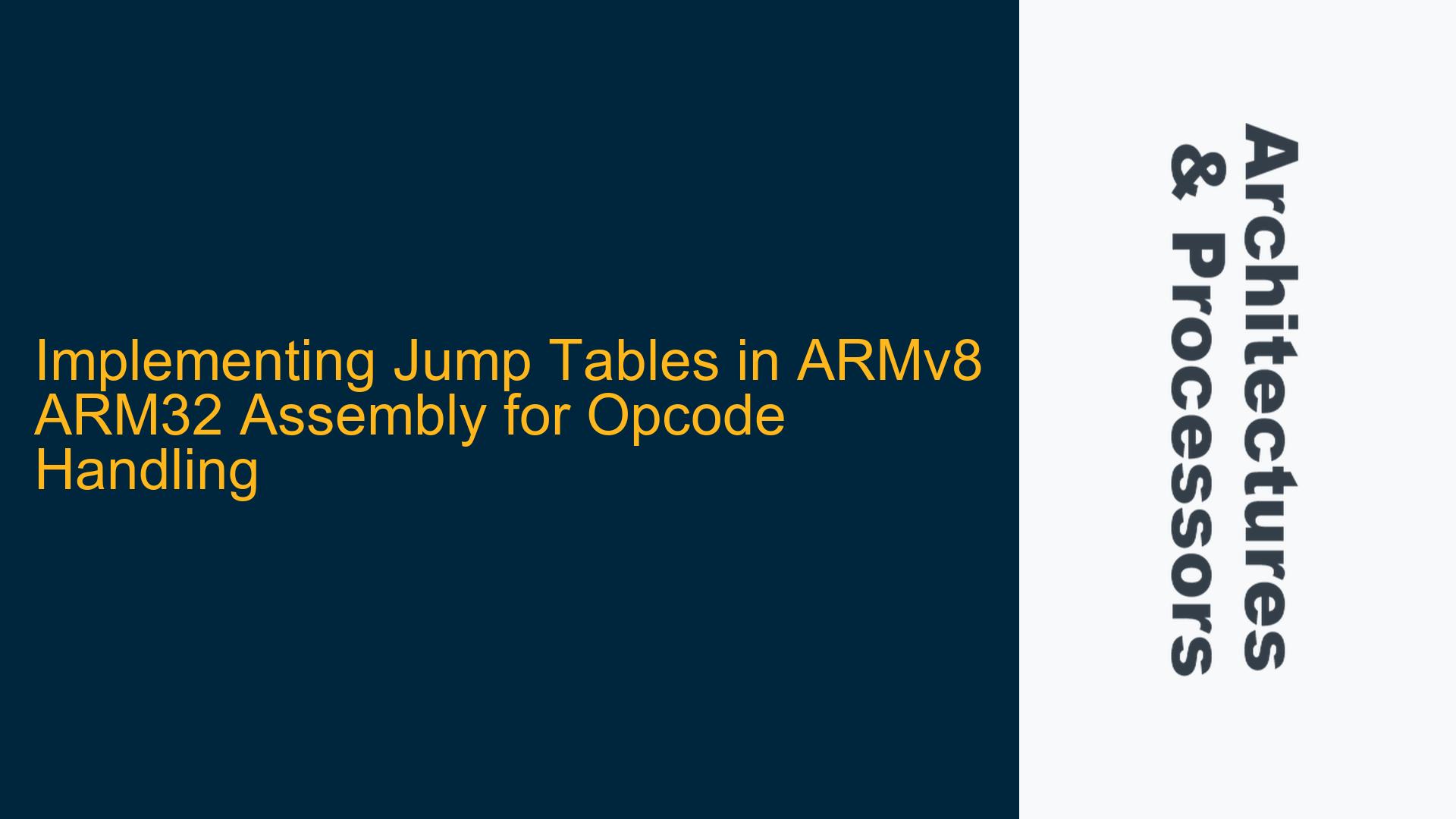ARMv8 ARM32 Jump Table Implementation for 256 Opcode Handlers
When working with ARMv8 ARM32 assembly, one common requirement is to implement a jump table to handle multiple opcodes efficiently. This is particularly useful when emulating an 8-bit computer with 256 possible opcodes, where each opcode corresponds to a specific handler. The challenge lies in creating a jump table that allows branching to the correct handler based on the opcode index. This guide will delve into the intricacies of implementing such a jump table, covering the necessary assembly instructions, memory organization, and potential pitfalls.
Understanding ARMv8 ARM32 Branch Instructions and Memory Addressing
The ARMv8 ARM32 architecture provides several branch instructions, such as BL (Branch and Link), which is commonly used for subroutine calls. However, BL requires a direct label, making it unsuitable for dynamic branching based on an index. To achieve this, we need to use a jump table—a data structure that contains the addresses of the opcode handlers. The key to implementing a jump table lies in understanding how to store and retrieve these addresses dynamically.
In ARM assembly, memory addressing modes allow us to access data stored at specific memory locations. The LDR (Load Register) instruction is particularly useful for this purpose, as it can load a value from memory into a register. By organizing the jump table as an array of addresses, we can use the opcode as an index to load the corresponding handler address into the program counter (PC), effectively branching to the desired handler.
The ARMv8 ARM32 architecture also supports the TBB (Table Branch Byte) and TBH (Table Branch Halfword) instructions, which are designed specifically for jump tables. These instructions simplify the process by allowing relative branching based on a table of offsets. However, their usage can be less intuitive, especially for those new to ARM assembly.
Potential Issues with Memory Alignment and Offset Calculation
One of the primary challenges in implementing a jump table is ensuring proper memory alignment. ARM architectures typically require word-aligned memory accesses, meaning that addresses should be multiples of 4. Misalignment can lead to performance penalties or even hardware exceptions. When defining a jump table, it is crucial to ensure that each entry is properly aligned.
Another issue is the calculation of offsets. The TBB and TBH instructions use relative offsets, which can be tricky to compute manually. Each entry in the jump table must contain the correct offset to the corresponding handler, and any miscalculation can result in branching to the wrong address. This is particularly problematic when dealing with a large number of opcodes, as even a small error can propagate and cause significant issues.
Additionally, the size of the jump table must be considered. With 256 opcodes, the jump table will contain 256 entries, each occupying 4 bytes (for a 32-bit address). This results in a total size of 1 KB for the jump table alone. Ensuring that this memory is allocated correctly and does not overlap with other critical data is essential for reliable operation.
Step-by-Step Implementation of a Jump Table in ARMv8 ARM32 Assembly
To implement a jump table in ARMv8 ARM32 assembly, follow these steps:
-
Define the Opcode Handlers: Start by defining the labels for each opcode handler. For example, if you have four opcodes (ADD, SUB, MUL, DIV), define the corresponding labels:
ADD: ; Handler for ADD opcode BX LR SUB: ; Handler for SUB opcode BX LR MUL: ; Handler for MUL opcode BX LR DIV: ; Handler for DIV opcode BX LR -
Create the Jump Table: Define the jump table as an array of addresses. Each entry in the table should correspond to the address of an opcode handler:
jump_table: .word ADD .word SUB .word MUL .word DIV -
Load the Opcode Index: Assume that the opcode index is stored in a register, such as
R0. Use this index to calculate the address of the corresponding entry in the jump table:LDR R1, =jump_table ; Load the base address of the jump table LDR R2, [R1, R0, LSL #2] ; Load the address of the handler (R0 is the index) -
Branch to the Handler: Use the loaded address to branch to the corresponding handler:
BX R2 -
Handle Return from Subroutine: Ensure that each handler ends with a
BX LRinstruction to return to the caller.
Example Code
Here is a complete example demonstrating the implementation of a jump table for four opcodes:
.global _start
_start:
; Assume R0 contains the opcode index (0 for ADD, 1 for SUB, etc.)
LDR R1, =jump_table ; Load the base address of the jump table
LDR R2, [R1, R0, LSL #2] ; Load the address of the handler
BX R2 ; Branch to the handler
jump_table:
.word ADD
.word SUB
.word MUL
.word DIV
ADD:
; Handler for ADD opcode
BX LR
SUB:
; Handler for SUB opcode
BX LR
MUL:
; Handler for MUL opcode
BX LR
DIV:
; Handler for DIV opcode
BX LR
Using TBB and TBH Instructions
For more complex scenarios, the TBB and TBH instructions can be used to implement jump tables with relative offsets. Here’s an example using TBB:
.global _start
_start:
; Assume R0 contains the opcode index (0 for ADD, 1 for SUB, etc.)
LDR R1, =jump_table ; Load the base address of the jump table
TBB [R1, R0] ; Table Branch Byte (R0 is the index)
jump_table:
.byte (ADD - jump_table) / 2
.byte (SUB - jump_table) / 2
.byte (MUL - jump_table) / 2
.byte (DIV - jump_table) / 2
ADD:
; Handler for ADD opcode
BX LR
SUB:
; Handler for SUB opcode
BX LR
MUL:
; Handler for MUL opcode
BX LR
DIV:
; Handler for DIV opcode
BX LR
Memory Alignment Considerations
Ensure that the jump table is properly aligned. For example, if using .word directives, the assembler will typically align the data to word boundaries. However, if using .byte directives with TBB, manual alignment may be necessary:
.align 2
jump_table:
.byte (ADD - jump_table) / 2
.byte (SUB - jump_table) / 2
.byte (MUL - jump_table) / 2
.byte (DIV - jump_table) / 2
Debugging and Testing
After implementing the jump table, thorough testing is essential. Verify that each opcode index correctly branches to the corresponding handler. Use a debugger to step through the code and inspect the values of registers and memory locations. Pay particular attention to the alignment of the jump table and the correctness of the offsets.
Performance Optimization
For performance-critical applications, consider the following optimizations:
- Minimize Branch Penalties: Ensure that the jump table and handlers are located in close proximity to reduce branch penalties.
- Cache Utilization: Organize the jump table and handlers to maximize cache utilization, reducing memory access latency.
- Instruction Pipelining: Structure the code to take advantage of the ARM pipeline, avoiding stalls and ensuring smooth execution.
Conclusion
Implementing a jump table in ARMv8 ARM32 assembly is a powerful technique for handling multiple opcodes efficiently. By understanding the architecture’s branch instructions, memory addressing modes, and alignment requirements, you can create a robust and performant jump table. Whether using direct address loading or the TBB/TBH instructions, careful planning and testing are essential to ensure correct operation. With the steps and examples provided in this guide, you should be well-equipped to implement jump tables in your ARMv8 ARM32 projects.






